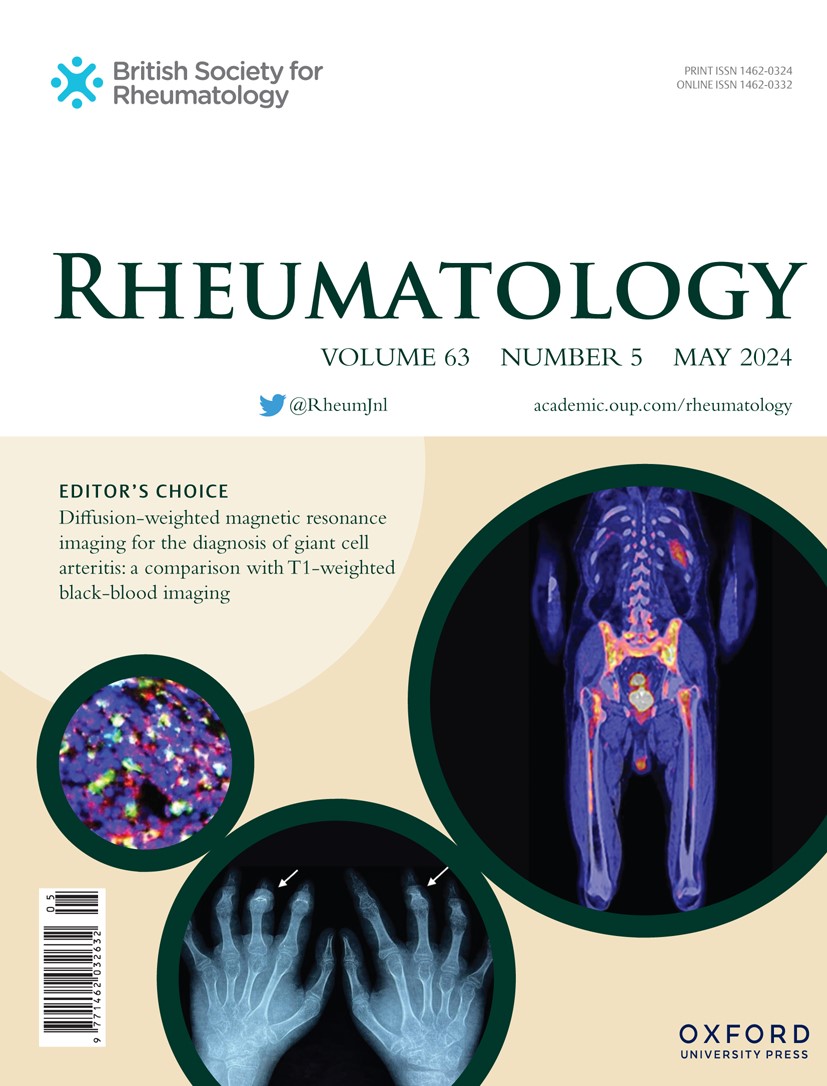P091 Mortality rates in children, young people, and young adults with JIA using UK GP data
IF 4.7
2区 医学
Q1 RHEUMATOLOGY
引用次数: 0
Abstract
Background/Aims JIA affects approximately 1-2 in 2000 children and young people in the UK. Rheumatological conditions are known to impact mortality; however, there is conflicting evidence regarding mortality rate and impact in JIA. The aim of this study was to calculate the all-cause mortality rate of patients with JIA, compared with (a) matched-controls, and (b) general population estimates. Methods Using UK General Practice data, CPRD (Aurum+Gold), this analysis included both prevalent and incident JIA cases under the age of 16 years old. Non-JIA control patients were matched 4-to-1 based on year of birth, gender, and practice. Date of death was identified through CPRD, or NHS-linked data (including cause of death). Exposure started on first JIA code date (or matched-date for controls) or 1-Jan-2000, whichever was latest. Follow-up continued until cut-off date (31-Dec-2018), or death, whichever was first. Cox-proportional hazards model was used to compare mortality in JIA versus matched-controls. JIA rates were additionally stratified by systemic versus non-systemic JIA. Standardised mortality rates (SMRs) were generated for JIA compared with the ONS general population estimates, based on calendar year, year of age, and gender. All patients were from England, due to the requirement for linkage with NHS hospital data. Results 4983 children and young people with JIA, and 14604 matched-control patients, were identified (Table); patient characteristics were similar between the cohorts. Mortality rate for JIA patients was 6.3/10000 person years (95%CI:4.4-8.9), and 2.0/10000 person years (95%CI:1.4-2.8) for control patients; JIA patients had 3.2 times higher mortality (95%CI:1.9-5.2). Patients with systemic JIA had 2.9 times higher mortality (95%CI:1.3-6.2) versus patients with non-systemic JIA (crude rate 13.9/10000 versus 5.2/10000). The SMR for JIA was 2.9 (95%CI:2.1-4.1); JIA patients had 2.9 times higher mortality versus the general population. Fifteen (47%) JIA deaths occurred before 2010. Conclusion This analysis calculated mortality rates in young people with JIA in the UK and found that death in young people with JIA is exceedingly rare. Slightly higher rates were observed in patients with systemic JIA, with approximately one additional death for every 2500 years versus controls. Almost half the deaths occurred before 2010 when biologic treatment, particularly for systemic JIA, was limited. Disclosure L. Kearsley-Fleet: None. N. Shaw: None. J. Leslie: None. M. Johnson: None. L.R. Wedderburn: None. K.L. Hyrich: None. J.H. Humphreys: None.使用英国全科医生数据的儿童、青年和年轻成人JIA的死亡率
背景/目的在英国,每2000名儿童和青少年中大约有1-2人患有JIA。已知风湿病会影响死亡率;然而,关于JIA的死亡率和影响存在相互矛盾的证据。本研究的目的是计算JIA患者的全因死亡率,并与(a)匹配对照和(b)一般人群估计值进行比较。方法使用英国全科数据CPRD (Aurum+Gold),分析16岁以下JIA的流行和发病病例。非jia对照患者根据出生年份、性别和执业情况进行4比1匹配。通过CPRD或与nhs相关的数据(包括死因)确定死亡日期。暴露开始于第一个JIA代码日期(或对照的匹配日期)或2000年1月1日,以最晚者为准。随访持续到截止日期(2018年12月31日),或死亡,以先到者为准。采用cox -比例风险模型比较JIA组与匹配对照组的死亡率。JIA发生率还根据系统性与非系统性JIA进行分层。根据历年、年龄和性别,将JIA的标准化死亡率(SMRs)与国家统计局的一般人口估计值进行比较。由于需要与NHS医院数据联系,所有患者都来自英格兰。结果共发现4983例JIA患儿和14604例匹配对照患者(表);两组患者的特征相似。JIA患者的死亡率为6.3/10000人年(95%CI:4.4-8.9),对照组为2.0/10000人年(95%CI:1.4-2.8);JIA患者的死亡率高出3.2倍(95%CI:1.9-5.2)。全身性JIA患者的死亡率是非全身性JIA患者的2.9倍(95%CI:1.3-6.2)(粗死亡率13.9/10000 vs 5.2/10000)。JIA的SMR为2.9 (95%CI:2.1 ~ 4.1);JIA患者的死亡率是一般人群的2.9倍。15例(47%)JIA死亡发生在2010年之前。结论本分析计算了英国青年JIA患者的死亡率,发现青年JIA患者的死亡极为罕见。在系统性JIA患者中观察到的死亡率略高,与对照组相比,大约每2500年增加1例死亡。几乎一半的死亡发生在2010年之前,当时生物治疗,特别是全身性JIA,是有限的。科尔斯利-弗利特:没有。N.肖:没有。莱司利:没有。约翰逊先生:没有。L.R. Wedderburn:没有。K.L.海里希:没有。j·h·汉弗莱斯:没有。
本文章由计算机程序翻译,如有差异,请以英文原文为准。
求助全文
约1分钟内获得全文
求助全文
来源期刊

Rheumatology
医学-风湿病学
CiteScore
9.40
自引率
7.30%
发文量
1091
审稿时长
2 months
期刊介绍:
Rheumatology strives to support research and discovery by publishing the highest quality original scientific papers with a focus on basic, clinical and translational research. The journal’s subject areas cover a wide range of paediatric and adult rheumatological conditions from an international perspective. It is an official journal of the British Society for Rheumatology, published by Oxford University Press.
Rheumatology publishes original articles, reviews, editorials, guidelines, concise reports, meta-analyses, original case reports, clinical vignettes, letters and matters arising from published material. The journal takes pride in serving the global rheumatology community, with a focus on high societal impact in the form of podcasts, videos and extended social media presence, and utilizing metrics such as Altmetric. Keep up to date by following the journal on Twitter @RheumJnl.
 求助内容:
求助内容: 应助结果提醒方式:
应助结果提醒方式:


